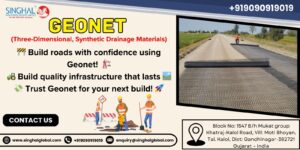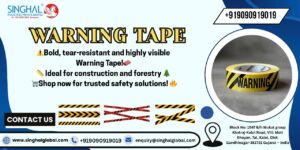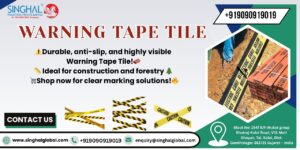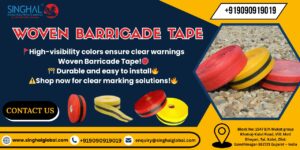Visibility, durability, and reliability in construction, emergency services, crowd control, and hazard warnings are crucial. The barricade tape, over time, has become a very necessary marking tool in hazardous areas, especially for safety applications across various industries. The development of the woven barricade tape has been an improved version from its basic simple warning form to become the essential tool for several applications in safety.
Early beginnings: simplicity and practicality
In its earliest form, Barricade tape was actually just a simple piece of plastic or fabric used for marking off areas that needed to be restricted or avoided. Frequently made from non-durable materials, such as the thinnest polyethylene, it was good for short-term use but lacking in strength to withstand longer outdoor conditions. Its one main purpose was to grab the eye and indicate the hazard.
Early barricade tape designs often used bright colors, which could be yellow or orange, with very simple wording, such as “Caution” or “Danger.” Although the early tapes were somewhat successful, they suffered from being not particularly visible under bad conditions. A weak tape could be easily torn apart by wind, degraded due to sun exposure, or damaged because of environmental causes such as rain or snow. Woven barricade tape suppliers always manufactured the high-quality of barricade tape.
Material Innovations: The Move to Power and Hardiness
As the sense of protection consciousness enhance within industries, it was pragmatic that stronger and more visible tape was needed for barricades. In the 1980s and 1990s, manufacturers started exploring different materials to increase the durability and reliability of the tape. Woven fabrics instead of flimsy plastics were introduced during this time, which significantly improved the strength and durability of the barricade tape, particularly outdoors.
Usually made of a high-strength synthetic yarn such as polyester or nylon, the strength offered to the tape in comparison is much greater compared to common plastic tapes. These transitions to woven made it resilient to tear off and tare by foreign external matters. Woven tapes may withstand wind strength, sun rays, water moisture thus making it many folds ideal for longer and grudge use under stringent situations. This made woven barricade tape more cost-effective and reliable in the long term.
Increased Visibility: Reflective and Fluorescent Features
One of the very important functions of barricade tape is to attract one’s attention and signal a warning. Early tapes usually were very colorful, though their visibility was limited within daylight or optimal lighting. Manufacturers soon began adding reflective and fluorescent elements to the woven barricade tape for better visibility.
Reflective tapes contain materials that reflect light, thus making the tape visible even in low-light conditions. This was useful for night-time work or when ambient lighting was at a minimum. Reflective woven barricade tape will ensure hazards are still visible in the dark, minimizing the likelihood of accidents or injuries during off-hours.
Fluorescent tapes, however, gain better visibility in daylight hours. These tapes are put to emit bright, shining colors under the sunlight thereby ensuring that the hazard area is highly visible, as in construction areas or bust streets. Bright fluorescent colour combined with reflective properties would create a highly effective kind of tape which provides even around-the-clock visibility.
Today, Woven safety tape is woven in various colors and patterns for specific uses. The most common colors are bright orange, yellow, and red because they are the most visible colors in a variety of environments. Custom-printed barricade tapes also allow companies to identify their safety efforts while still being highly visible. Singhal Industries is a leading Woven barricade tape manufacturer.
Increased Utility: Multi-Purpose Use
Woven barricade tape has also evolved into various industries and specific uses. While originally used to indicate danger zones, modern woven barricade tape is used for many purposes:
Construction and Industrial Sites: Tape is used to mark off danger zones in construction sites due to heavy machinery or uncovered pits. Its strength makes it possible to withstand strong wind, rain, and a long period of sun exposure.
Crowd Control: Woven barricade tape is used in crowd control situations, such as concerts, festivals, or sporting events. It is lightweight but robust, allowing event organizers to set up or dismantle temporary barriers quickly while still having a clear view.
Emergency Services: Woven barricade tape is often used by first responders to secure accident sites, crime scenes, or areas with hazardous materials. This tape keeps the area isolated and prevents unauthorized access until it is safe to approach.
Woven Barricade Tape Traffic and Road Safety Woven barricade tape is used to cordon off roadwork zones or accident sites to ensure that drivers and pedestrians remain at a safe distance. The reflective feature is especially useful for applications at night on the roadways.
Environmental and Wildlife Preservation: At times, such tape is used to secure sensitive ecosystems or wildlife refuge. The tape could also be used to block or mark areas where humans can’t enter, in that way conserving the nature while causing minimal disruption.
Design Innovation: Personalization and Branding
More specialties led the Woven barricade tape manufacturer to present a wide range of custom choices. Now, besides being used for different purposes using the woven barricade tape, this product was also ready to be used with custom logos, messages, or even safety instructions printed right on the tape. This further gives a professional feel and identifies the brand name with the setup.
There are also a multitude of designs nowadays that suit specified needs. For example, there are woven barricade tapes with higher resistance from UV light, perfect to use in the outdoor environments for longer periods of exposure. Some may have other specialized color combinations or print important warning signs like “No Entry” or “Authorized Personal Only,” clearly defining the risk to which people are exposed as well as the area for restriction.
Future: Smart Tape and Sustainability
Thereby, with more evolved and advanced technology, such potential developments are limitless to speak of. For now, the future of the weave barricade tape should always be about the new improved safety measures. Indeed, one of the features a future development could encompass into the barricade tape may be smart technologies in order to make it also one that can sense surroundings when there is a significant alteration. For instance, tape may have temperature sensors to identify heat-related hazards or motion sensors to alert of entry by someone into a restricted zone.
The environmental front is also getting much attention in sustainable woven barricade tapes development. The traditional materials used for manufacturing barricade tapes lead to plastic waste, and so research into biodegradable or recyclable alternatives is in progress.
Conclusion: A Simple yet Effective Tool
Woven barricade tape: An example of how even a simple, active, protection tool might be refined to fulfill new needs placed on modern industry. In fact, from humble origins in flimsy strips of plastic to its now solidly recognized function as the visible and dependable safety means it stands for today, woven barricade tape stands out among an array of products helping keep people safe.
Frequently Asked Questions (FAQs)
How is woven barricade tape diverse from standard plastic tape?
Woven Barricade Tape is a sturdy, flexible, and highly noticeable tool that is manufactured for different purposes. It is made from woven fabrics like plastic, fabric, or vinyl, ensuring durability and longevity that make it different from usual barricade tapes.
Is woven barricade tape weatherproof?
Resists wind, rain, snow, and other harsh elements. This structure makes it appropriate for usage in long term projects.
What industries benefit from woven barricade tape?
Following are the applications of Woven Barricade Tape
- Construction Job sites.
- Forestry.
- Hardware & unities.
- Oil Exploration.
- Nursery.
- Mining.
- Dangerous & Hazardous Areas.
- Temporary & Permanent Restricted Areas.









